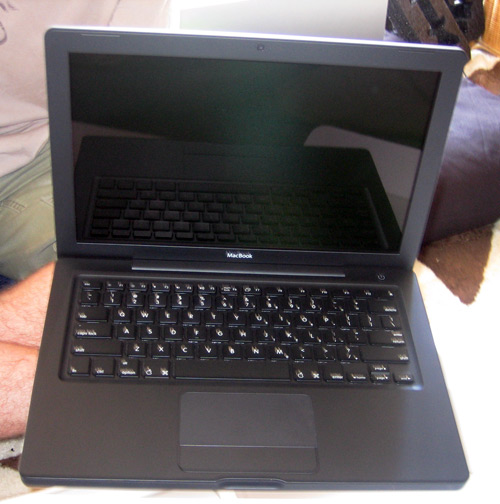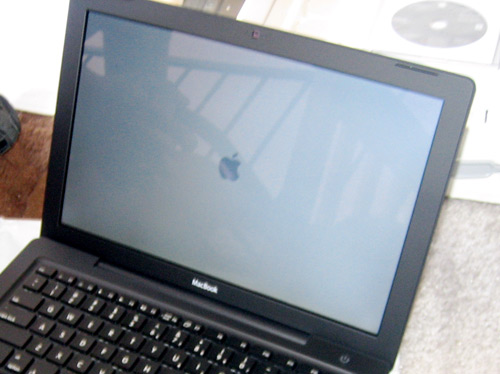Hypercritical
And we all shine on
Laptop as fishing lure.
The new MacBook comes with what Apple calls a “13.3-inch glossy widescreen display.” The key word there is “glossy,” and it serves as a warning to the scant few Mac users who immediately know what it means in this context.
In recent years, PC laptops have started sprouting LCD screens with shiny surfaces. Glossy, you might say. It started with just a few models. Today, you’ll be hard-pressed to find any PC laptops with non-glossy screens at your local Best Buy or Circuit City.
Meanwhile, Apple’s laptops have stuck with their traditional matte-finish screens. That’s changed with the introduction of the MacBook and its glossy display. The MacBook Pro now has a glossy display option as well.
So, what’s the big deal? Consider some synonyms for the word “glossy.” Gleaming. Shiny. Reflective. Now you’re getting it.
When the screen is off, it’s basically a mirror. Fine. Who cares what it looks like when it’s off, right? Let’s boot this baby up and bask in the glow of our lustrous, glistening, shimmering screen!

Windows or fluorescent lights? You decide.
These pictures demonstrate why so many Mac users read the phrase “glossy display” with a heavy heart. Reflections! Glare! These are not good things!
I didn’t have hunt for these pictures, by the way. They were taken from the very first “unofficial” set of MacBook photos that I saw on the web today. This is really what this kind of screen looks like. When they say “glossy,” they mean it.
Glossy displays have effectively taken over the entire laptop market. Why are they so popular? Here are three possible reasons.
- They are better than matte-finish displays.
- They are cheaper than matte-finish displays.
- People are idiots.
Before we look at the whole market, let’s briefly consider only Apple, the latecomer to the shiny screen party. Why did Apple go glossy? When answering that question, reason number two looks very persuasive. If the entire PC laptop market has moved to glossy displays, it may be difficult for Apple to find anyone to sell them matte-finish displays at all, let alone sell them at competitive prices.
But I don’t know how different the manufacturing process is for glossy and matte-finish screens. Maybe it’s trivial to make one or the other in the same plant. More broadly speaking, I suppose it’s possible that glossy displays are somehow inherently cheaper to manufacture than matte-finish displays—enough so that the entire industry switched over. Again, I don’t know enough about the actual manufacturing process to definitively rule this out, but my gut tells me that it’s unlikely.
As for reason number one, that glossy displays are “better” than matte-finish displays, I must rule by fiat. For any reasonable definition of “better” that I can think of, the answer is a big, fat, “no.” Maybe you don’t think glare is an issue. Maybe you always view the screen head-on in perfectly diffuse lighting. Maybe you think the benefits of the glossy screen outweigh the drawbacks. Whatever the reason, we’ll just have to agree to disagree on this issue. You can probably stop reading now.
Now we come to reason number three: people are idiots. Put another way, people like shiny things. When the glossy screens first started to appear in Best Buy and CompUSA, the contrast with their non-glossy brethren was striking. Walking into the laptop aisle, your eye was immediately drawn to the glossy displays. Aside from the shine, there’s also a perceptible difference in sharpness and color saturation on glossy screens. These things stand out.
In “shopping mode,” this is all people see. Shiny, saturated, sharp. Customers aren’t trying to read the screens or move the laptops to different locations in different kinds of lighting. Shopping is almost always an emotional experience, not a rational one. The fallout is predictable, particularly in the world of retail electronics. I’ll just give my two favorite examples.
Electronics departments usually have the products out on the floor or lined up against a wall, grouped by product type. This makes “comparison shopping” easy. People like to compare; it makes them feel more confident about their decisions. Confident people spend.
Unfortunately, people are lousy at making sensible comparisons. Take televisions, for my first example. When comparison shopping for TVs of a given size, there is one picture quality attribute that dominates all others: brightness. Brighter TVs “look better.” Differences in color saturation, uniformity, sharpness, black level, you name it, can all be overshadowed by cranking up the brightness on one TV. You can take out a video essentials DVD and “prove” that one TV has better objective picture quality than another, and people will still insist that you’re wrong and proceed to buy the brighter TV instead.
The second example is the world of speakers. The rule here is similar. Louder speakers “sound better.” This one is even more crushing. You can make nearly anyone buy anything in one of those “listening rooms” by simply making one set of speakers slightly louder than another. Incidentally, you can also see this in the recording industry. The volume of recorded music has been creeping up for years. Music on modern CDs is compressed to an absurd degree, destroying the dynamic range in order to increase the overall volume. Different product, same principle: louder “sounds better.”
Back to shiny laptop screens. It seems pretty obvious to me that shiny “looks better,” and that’s why it’s taken over the laptop market. This makes me sad, and not a little bitter. Thus, reason number three. People are idiots. I declare it the winner!
I can’t really rule out the cost issue without more information, of course. But for now, I’m sticking with the idiot theory. With that premise, let’s try to assign blame for the MacBook glossy conversion. There’s an idiot here somewhere, but maybe it’s not the consumer this time.
Mac users are an odd bunch. We’ve been buying matte-finish laptops long after the PC laptop world went glossy, and there hasn’t exactly been any outcry over the “gloss gap.” So it seems to me that Mac users are not the idiots here, demanding shiny screens on their various <blank>Books for emotional reasons.
We’ve set aside cost for the sake of argument, and we’ve eliminated the idiot consumer as a factor. Only Apple itself is left. The long-standing tradition of Apple punditry demands that Apple be personified in the form of one Steve Jobs, and so I will now consider the possibility that all blame for the GlossBook and GlossBook Pro lies entirely on him.
Jobs has proven time and again that he’s willing to place superficial perception well above more practical concerns. If he thinks that shiny screens “look better,” then it’s not so far-fetched to imagine that he initiated the move to glossy screens. I certainly wouldn’t put it past him.
So, to sum up. Glossy screens: bad. People: idiots. Steve Jobs: insane. This post: too long. Blah.
This article originally appeared at Ars Technica. It is reproduced here with permission.

